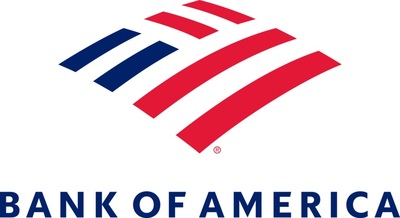Affluent Americans Increase Donations by 30% Over Past Decade, Even as Fewer Give, Finds 2025 BofA Study of Philanthropy
Bank of America (NYSE:BAC) released its 2025 Study of Philanthropy, revealing a complex shift in charitable giving among affluent Americans. The study shows that while total charitable contributions from wealthy donors have increased by over 30% since 2015, the percentage of affluent households making donations has decreased from 91% to 81% during the same period.
Key findings include: volunteering has rebounded from 30% to 43% since 2020, with volunteers giving twice as much as non-volunteers. 79% of donors support local communities, focusing primarily on basic needs (43%) and religious services (38%). Religious organizations receive the largest share of donations at 39%, followed by basic needs (16%) and higher education (14%).
The study, based on a survey of 1,514 households with net worth over $1 million, also found that strategic giving vehicles increased from 11% to 18% of charitable gifts since 2015.
Banks of America (NYSE:BAC) ha pubblicato il suo Studio sulla Filantropia 2025, rivelando un complesso cambiamento nelle donazioni caritatevoli tra gli americani benestanti. Lo studio mostra che mentre le contribuzioni filantropiche totali dei donatori ricchi sono aumentate di oltre il 30% dal 2015, la percentuale di famiglie benestanti che effettuano donazioni è diminuita dall'91% all'81% nello stesso periodo.
Principali risultati: il volontariato è rimbalzato dal 30% al 43% dal 2020, con i volontari che donano il doppio rispetto ai non volontari. Il 79% dei donatori sostiene le comunità locali, concentrandosi principalmente su bisogni di base (43%) e servizi religiosi (38%). Le organizzazioni religiose ricevono la quota maggiore delle donazioni al 39%, seguite da bisogni di base (16%) e istruzione superiore (14%).
Lo studio, basato su un sondaggio di 1.514 famiglie con patrimonio netto superiore a 1 milione di dollari, ha anche rilevato che i veicoli di donazione strategica sono aumentati dall'11% al 18% dei doni caritativi dal 2015.
Bank of America (NYSE:BAC) publicó su Estudio de Filantropía 2025, revelando un complejo cambio en las donaciones caritativas entre los estadounidenses adinerados. El estudio muestra que, si bien las contribuciones caritativas totales de los donantes ricos han aumentado más de un 30% desde 2015, el porcentaje de hogares adinerados que realizan donaciones ha disminuido del 91% al 81% en el mismo periodo.
Hallazgos clave: el voluntariado ha rebotado del 30% al 43% desde 2020, con los voluntarios donando el doble que los no voluntarios. El 79% de los donantes apoya a las comunidades locales, centrándose principalmente en las necesidades básicas (43%) y los servicios religiosos (38%). Las organizaciones religiosas reciben la mayor parte de las donaciones, con un 39%, seguidas por necesidades básicas (16%) y educación superior (14%).
El estudio, basado en una encuesta de 1.514 hogares con un patrimonio neto superior a 1 millón de dólares, también encontró que los vehículos de donación estratégica aumentaron del 11% al 18% de las donaciones caritativas desde 2015.
뱅크오브아메리카(BAC)의 2025년 자선 연구가 발표되었으며, 부유한 미국인들 사이에서 자선 기부의 복잡한 변화를 드러냅니다. 연구에 따르면 2015년 이후 부유한 기부자들의 총 자선 기부는 30% 이상 증가했지만, 같은 기간에 기부를 하는 부유한 가구의 비율은 91%에서 81%로 감소했습니다.
주요 발견: 2020년 이후 자원봉하는 비율이 30%에서 43%로 회복되었으며, 자원봉사자는 비자원봉사자의 두 배를 기부합니다. 기부자의 79%가 지역 사회를 지원하며 주로 기본 필요(43%)와 종교 서비스(38%)에 초점을 맞춥니다. 종교 단체가 기부의 가장 큰 몫을 차지하며 39%를 기록했고, 그 뒤를 기본 필요(16%)와 고등교육(14%)이 이었습니다.
이 연구는 순자산이 100만 달러를 넘는 1,514가구를 대상으로 한 설문조사에 기반하며, 또한 2015년 이후 전략적 기부 수단이 기부의 11%에서 18%로 증가했습니다.
Bank of America (NYSE:BAC) a publié son Étude 2025 sur la philanthropie, révélant un changement complexe dans les dons caritatifs parmi les Américains aisés. L'étude montre que, bien que les contributions caritatives totales des donateurs riches aient augmenté de plus de 30% depuis 2015, la proportion de ménages aisés qui font des dons est passée de 91% à 81% au cours de la même période.
Principales conclusions: le bénévolat est remonté de 30% à 43% depuis 2020, les bénévoles donnant le double des non-volontaires. 79% des donateurs soutiennent les communautés locales, en se concentrant principalement sur les besoins fondamentaux (43%) et les services religieux (38%). Les organisations religieuses reçoivent la plus grande part des dons à 39%, suivies des besoins fondamentaux (16%) et de l’enseignement supérieur (14%).
L’étude, fondée sur une enquête auprès de 1 514 ménages dont la valeur nette est supérieure à 1 million de dollars, a également révélé que les véhicules de dons stratégiques ont augmenté de 11% à 18% des dons caritatifs depuis 2015.
Bank of America (NYSE:BAC) hat seine 2025-Studie zur Philanthropie veröffentlicht, die eine komplexe Verschiebung bei karitativen Spenden unter wohlhabenden Amerikanern zeigt. Die Studie zeigt, dass die gesamten philanthropischen Beiträge wohlhabender Spender seit 2015 um über 30% gestiegen sind, der Anteil der wohlhabenden Haushalte, die Spenden tätigen, sich im gleichen Zeitraum jedoch von 91% auf 81% verringert hat.
Wichtige Erkenntnisse: Freiwilligenarbeit ist seit 2020 von 30% auf 43% gestiegen, Freiwillige geben doppelt so viel wie Nicht-Freiwillige. 79% der Spender unterstützen lokale Gemeinschaften, mit Fokus auf Grundbedürfnisse (43%) und religiöse Dienstleistungen (38%). Religiöse Organisationen erhalten den größten Anteil der Spenden mit 39%, gefolgt von Grundbedürfnissen (16%) und Hochschulbildung (14%).
Die Studie basiert auf einer Umfrage unter 1.514 Haushalten mit einem Nettovermögen von über 1 Million US-Dollar und zeigte außerdem, dass strategische Spendenvehikel von 11% auf 18% der Wohltätigkeit seit 2015 gestiegen sind.
د بنك أوف أميركا (NYSE:BAC) نشر دراسة 2025 حول العمل الخيري، كاشفاً عن تحول معقد في التبرعات الخيرية بين الأمريكيين الأثرياء. تُظهر الدراسة أنه بينما ارتفعت المعونات الخيرية الإجمالية من المتبرعين الأثرياء بأكثر من 30% منذ 2015، انخفضت نسبة الأسر الثرية التي تقدم تبرعات إلى 81% من 91% في نفس الفترة.
النتائج الرئيسية: عاد العمل التطوعي من 30% إلى 43% منذ 2020، والمتطوعون يتبرعون بما يفوق ما يتبرع به غير المتطوعين بمقدار الضعف. 79% من المتبرعين يدعمون المجتمعات المحلية، مع تركيزهم الأساسي على الاحتياجات الأساسية (43%) والخدمات الدينية (38%). تتلقى المؤسسات الدينية الحصة الأكبر من التبرعات بنحو 39%، تليها الاحتياجات الأساسية (16%) والتعليم العالي (14%).
اعتمدت الدراسة على مسح شمل 1,514 أسرة تفوق ثروتها الصافية المليون دولار، كما وجدت أن وسائل التبرع الاستراتيجي زادت من 11% إلى 18% من الهبات الخيرية منذ 2015.
美國銀行(NYSE:BAC)發布了其 2025 年慈善研究,揭示富裕美國人中慈善捐贈的複雜變化。研究顯示,儘管富有捐贈者的總慈善捐款自 2015 年以來增加了超過 30%,但在同一時期,捐款家庭在富裕家庭中的比例已從 91% 降至 81%。
主要發現包括:自 2020 年以來,志愿者活動已從 30% 回升至 43%,志愿者捐贈的金額是非志愿者的兩倍。捐贈者中有 79% 支持本地社區,主要聚焦於基本需求(43%)和宗教服務(38%)。宗教組織獲得最高比例的捐款,為 39%,其次是基本需求(16%)和高等教育(14%)。
該研究基於對 1,514 戶家庭的調查,淨資產超過 100 萬美元,同時發現自 2015 年以來,戰略性捐贈工具佔慈善捐贈的比例從 11% 增加到 18%。
- Charitable contributions from affluent donors increased by over 30% since 2015
- Volunteering rates recovered strongly from 30% to 43% since 2020
- Strategic giving vehicles usage increased from 11% to 18% of charitable gifts
- Average donations from volunteers are double those of non-volunteers
- Participation in charitable giving among affluent households declined from 91% to 81% since 2015
- Only 13% of donors involve younger family members in charitable decisions
- Less than half (40%) of affluent donors have a formal giving strategy
Volunteering Makes a Post-Pandemic Comeback; Those Who Volunteer Give Twice as Much
"This year's study highlights a desire among affluent Americans to make a real difference — often in their own backyards — by combining financial contributions and active engagement," said Katy Knox, President of Bank of America Private Bank. "It's inspiring to see so many individuals committed to positive change."
The biennial study offers an in-depth look at the evolving philanthropic landscape among affluent households. This year's report found volunteering is making a comeback, rising from
"Through this study, we illuminate how affluent donors, advisors and nonprofit organizations navigate today's changing philanthropy landscape," said Amir Pasic, Eugene R. Tempel Dean at the Indiana University Lilly Family School of Philanthropy. "In particular, personal connection and in-depth knowledge are central to the higher levels of engagement with their giving and with nonprofits that we see among more generous donors."
Notable themes from the study include:
-
Donors prioritize causes close to home. On average, affluent donors gave to five organizations in 2024, with
79% supporting their local communities. The causes to which the largest percentages of donors gave were basic needs (43% ) and religious services/development (38% ). -
A household-centered approach to giving.
46% of affluent households reported making charitable decisions jointly with their spouse or partner, while an additional11% said they collaborate on some giving decisions. However, only13% of donors report involving children, grandchildren or younger relatives. -
Religious organizations attract the highest share of dollars.
39% of affluent dollars donated were given to religious organizations, followed by causes focused on basic needs (16% ) and higher education (14% ). -
Strategic giving vehicles are on the rise. In 2024,
18% of charitable gifts were made through giving vehicles, up from11% nine years earlier.24% of affluent households have a giving vehicle, and48% of affluent households with a net worth between$5 million $20 million -
Giving with intention. Over
40% of affluent donors have a giving strategy,45% have a giving budget and20% actively monitor the impact of their gifts.62% of those who consider themselves "philanthropic experts" evaluate the impact of their gifts. - Expert givers give more. On average, those who identify as expert givers give more than six times more than those who identify as novices.
- Affluent donors have a variety of philanthropic identities. The study highlights five unique donor profiles: steadfast supporters, devout donors, entrepreneurs, changemakers and philanthropic experts.
Read more about the 2025 Bank of America Study of Philanthropy.
Methodology
The 2025 study is based on a nationally representative sample of 1,514 wealthy
About the Study
The Bank of America Study of Philanthropy is a biennial look at the giving and volunteering practices of affluent Americans, with intentions to provide insightful research data for use by nonprofit governing boards and professionals, charitable advisors, donors and others interested in philanthropy and the nonprofit sector. It has been researched and written at the Indiana University Lilly Family School of Philanthropy, in partnership with Bank of America, since 2006.
Indiana University Lilly Family School of Philanthropy
The Lilly Family School of Philanthropy is dedicated to improving philanthropy to improve the world by training and empowering students and professionals to be innovators and leaders who create positive and lasting change. The school offers a comprehensive approach to philanthropy through its undergraduate, graduate, certificate and professional development programs, its research and international programs, and through The Fund Raising School, Lake Institute on Faith & Giving, Mays Family Institute on Diverse Philanthropy, Women's Philanthropy Institute, and the Muslim Philanthropy Initiative. Follow us on X (formerly known as Twitter), LinkedIn, and Facebook.
Bank of America
Bank of America is one of the world's leading financial institutions, serving individual consumers, small and middle-market businesses and large corporations with a full range of banking, investing, asset management and other financial and risk management products and services. The company provides unmatched convenience in
Bank of America, its affiliates and advisors do not provide legal, tax or accounting advice. You should consult your legal and/or tax advisors before making any financial decisions.
Institutional Investments & Philanthropic Solutions (also referred to as "Philanthropic Solutions" or "II&PS") is part of Bank of America Private Bank, a division of Bank of America, N.A., Member FDIC and a wholly owned subsidiary of Bank of America Corporation ("BofA Corp."). Trust, fiduciary, and investment management services are provided by Bank of America, N.A., and its agents.
Banking products are provided by Bank of America, N.A., and affiliated banks, Members FDIC and wholly owned subsidiaries of Bank of America Corporation.
Investment products
|
Are Not FDIC Insured |
Are Not Bank Guaranteed |
May Lose Value |
For more Bank of America news, including dividend announcements and other important information, visit the Bank of America newsroom and register for news email alerts.
Reporters may contact
Julia Ehrenfeld, Bank of America
Phone: 1.646.855.3267
julia.ehrenfeld@bofa.com
Adriene Kalugyer, IU Lilly Family School of Philanthropy
Phone: 1.317.278.8972
adrldavi@iu.edu
![]() View original content to download multimedia:https://www.prnewswire.com/news-releases/affluent-americans-increase-donations-by-30-over-past-decade-even-as-fewer-give-finds-2025-bofa-study-of-philanthropy-302569728.html
View original content to download multimedia:https://www.prnewswire.com/news-releases/affluent-americans-increase-donations-by-30-over-past-decade-even-as-fewer-give-finds-2025-bofa-study-of-philanthropy-302569728.html
SOURCE Bank of America Corporation









